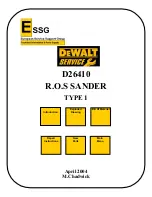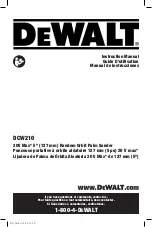
WARNING: ALWAYS use safety glasses. Everyday
eyeglasses are NOT safety glasses. Also use face or dust
mask if cutting operation is dusty. ALWAYS WEAR
CERTIFIED SAFETY EQUIPMENT:
• ANSI Z87.1 eye protection (CAN/CSA Z94.3),
• ANSI S12.6 (S3.19) hearing protection,
• NIOSH/OSHA/MSHA respiratory protection.
WARNING: Always wear proper personal hearing
protection that conforms to ANSI S12.6 (S3.19) during
use. Under some conditions and duration of use, noise
from this product may contribute to hearing loss.
WARNING: Use of this tool can generate and/or disperse
dust, which may cause serious and permanent respiratory
or other injury. Always use NIOSH/OSHA approved
respiratory protection appropriate for the dust exposure.
Direct particles away from face and body.
CAUTION: Use extra care when working into a corner
because a sudden, sharp movement of the polisher may
be experienced when the polishing mop or other
accessory contacts a secondary surface or a surface
edge.
WARNING: Some dust created by polishing contains
chemicals known to the State of California to cause can-
cer, birth defects or other reproductive harm. Some exam-
ples of these chemicals are:
• lead from lead-based paints,
• crystalline silica,
•arsenic and chromium from chemically-treated
lumber.
Summary of device labels containing safety information
Symbology
Symbol
Description
Symbol
Description
Canadian Standards Association
Hz
Hertz
Double insulated (Class II)
A
Ampere
Use personal protective
equipment
No
No-load speed
Volts Alternating Current
/min
Per minute
instructions.
4.The rated speed of the accessories must be at least
equivalent to the maximum speed specified on the tool.
Using the accessories at speeds above the rated one, may
cause them to break or be projected into the air.
5.The external diameter and thickness of the accessories
must match the specifications of the tool. Accessories with
incorrect dimensions cannot be adequately protected or
controlled.
6.The configuration of accessories must match the tool. The
use of accessories that cannot be perfectly fitted on the tool
may result in imbalance, excessive vibrations and in the
impossibility of controlling the tool.
7.Do not use damaged accessories. Before use, inspect all
the accessories. Inspect the supporting pads and verify
there are no cracks, tears or excessive wear. If the tool or
accessory has fallen, verify that they are not damaged or
install a new accessory. After inspecting or installing an
accessory, test the operation of the tool at maximum speed
and without load for one minute, keeping at a safety
distance. If the accessories are damaged, they will break
during this test.
8.Wear personal protective equipment. Depending on
application, use face shield,safety goggles or safety
glasses. As appropriate, wear dust mask, hearing
protectors, gloves and workshop apron capable of stopping
small abrasive or workpiece fragments. The eye protection
must be capable of stopping flying debris generated by
various operations. The dust mask or respirator must be
capable of filtrating particles generated by your operation.
Prolonged exposure to high intensity noise may cause hearing
loss.
9.Keep bystanders a safe distance away from work area.
Anyone entering the work area must wear personal
protective equipment. Fragments of workpiece or of a broken
accessory may fly away and cause injury beyond immediate
area of operation.
10.Hold power tool by insulated surfaces only, when
performing an operation where the cutting accessory may
contact hidden wiring or its own cord. Cutting accessory
contacting a “live” wire may make exposed metal parts of the
power tool “live” and shock the operator.
11.Position the cord clear of the spinning accessory. If you
lose control, the cord may be cut or snagged and your hand
or arm may be pulled into the spinning accessory.
12.Never lay the power tool down until the accessory has
come to a complete stop. The spinning accessory may grab
the surface and pull the power tool out of your control.
13.Do not run the power tool while carrying it at your side.
Accidental contact with the spinning accessory could snag
your clothing, pulling the accessory into your body.
14.Regularly clean the power tool’s air vents. The motor’s
fan will draw the dust inside the housing and excessive
accumulation of powdered metal may cause electrical
hazards.
15.Do not operate the power tool near flammable materials.
Sparks could ignite these materials.
16.Do not use accessories that require liquid coolants. Using
water or other liquid coolants may result in electrocution or
shock.
Further Safety Instructions for All Operations
KICKBACK AND RELATED WARNINGS
Kickback is a sudden reaction to a pinched or snagged rotating
wheel, backing pad, brush or anyother accessory. Pinching or
snagging causes rapid stalling of the rotating accessory which
in turn causes the uncontrolled power tool to be forced in the
direction opposite of the accessory’s rotation at the point of the
binding.
For example, if a polishing mop is snagged or pinched by the
workpiece, the edge of the mop that is entering into the pinch
point can dig into the surface of the material causing the mop
to climb out or kick out. The mop may either jump toward or
away from the operator, depending on direction of the mop’s
movement at the point of pinching. Polishing mops may also
break under these conditions.
Kickback is the result of tool misuse and/or incorrect operating
procedures or conditions and can be avoided by taking proper
precautions as given below:
1) Maintain a firm grip on the power tool and position your
body and arm to allow you to resist kickback forces. Always
use auxiliary handle, if provided, for maximum control over
kickback or torque reaction during start up. The operator
can control torque reaction or kickback forces, if proper
precautions are taken.
2) Never place your hand near the rotating accessory.
Accessory may kickback over your hand.
3) Do not position your body in the area where power tool
will move if kickback occurs. Kickback will propel the tool in
direction opposite to the wheel’s movement at the point of
snagging.
4) Use special care when working corners, sharp edges, etc.
Avoid bouncing and snagging the accessory. Corners, sharp
edges or bouncing have a tendency to snag the rotating
accessory and cause loss of control or kickback.
5) Do not attach a saw chain woodcarving blade or toothed
saw blade. Such blades create frequent kickback and loss of
control.
Additional Specific Safety Instructions for Polishers
• Always use eye protection. All users and bystanders must
wear eye protection that conforms to ANSI Z87.1.
• Clean out your tool often, especially after heavy use. Dust
and grit containing metal particles often accumulate on
interior surfaces and could create an electric shock hazard.
• Do not operate this tool for long periods of time. Vibration
caused by the operating action of this tool may cause
permanent injury to fingers, hands and arms. Use gloves to
provide extra cushion, take frequent rest periods and limit daily
time of use.
• Air vents often cover moving parts and should be avoided.
Loose clothes, jewelry or long hair can be caught in moving
parts.
• An extension cord must have adequate wire size (AWG or
American Wire Gauge) for safety. The smaller the gauge
number of the wire, the greater the capacity of the cable, that
is 16 gauge has more capacity than 18 gauge. An undersized
cord will cause a drop in line voltage resulting in loss of power
and overheating. When using more than one extension to
make up the total length, be sure each individual extension
contains at least the minimum wire size. The following table
shows the correct size to use depending on cord length and
nameplate ampere rating. If in doubt, use the next heavier
gauge. The smaller the gauge number, the heavier the cord.
Minimum Gauge for Cord Sets
Your risk from these exposures varies, depending on how often
you do this type of work. To reduce your exposure to these
chemicals: work in a well ventilated area, and work with
approved safety equipment, such as those dust masks that are
specially designed to filter out microscopic particles.
• Avoid prolonged contact with dust from polishing. Wear
protective clothing and wash exposed areas with soap and
water. Allowing dust to get into your mouth, eyes, or lay on
the skin may promote absorption of harmful chemicals.





































